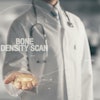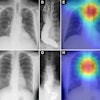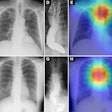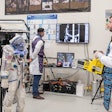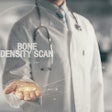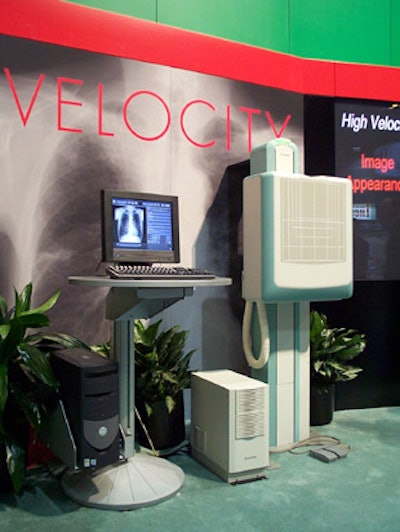
CHICAGO - Medical device developer Fujifilm Medical Systems of Stamford, CT, has come to the 88th annual RSNA with its quiver full of new products as well as enhancements to its existing lines.
The vendor this week unveiled the FCR Velocity, a high-throughput CR device that is capable of up to 240 images per hour, according to John Strauss, director of marketing for the firm. The product uses a linear light source and charge-coupled devices (CCDs) with a large aperture photodiode that reads and erases the 17” x 17” (43cm x 43cm) image receptor (IR) within 10 seconds.
The IR is a sealed system built around a newly developed imaging plate with a thicker layer of phosphor powder that enables a more efficient use of incident x-ray energy. The IR can be screened down to accommodate smaller-size imaging needs, and its tower-mounted support permits patient studies from foot- to head-level. The system acquires an image at 4k x 4k resolution for preview viewing and sends a 2k x 2k image for diagnostic and reference viewing.
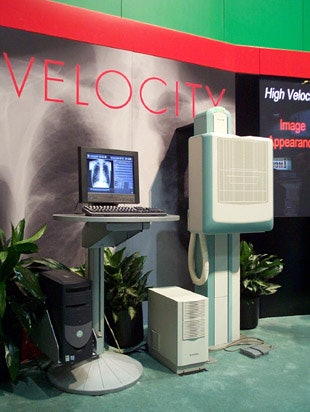 FCR Velocity features Fast LineScan technology that permits a throughput of up to 240 images per hour. |
The FCR Velocity is available as either an add-on to an existing generator and tube unit or can be configured as a complete system, according to Strauss. He believes that the product, expected to be available in the third quarter of 2003, will inspire institutions looking to DR for its high throughput to reconsider CR.
“With the Velocity’s high throughput, as well as the proven reliability of Fuji’s image-processing tools, there’s little reason to acquire a higher-priced DR system,” said Strauss.
Digital mammography
The company is looking to bring its long-awaited FCR 5000 MA to U.S. shores in late 2003, according to Strauss. The product, a CR-based digital mammography device, has been widely available in Europe and the Far East, and is expected to be submitted for U.S. Food and Drug Administration 510(k) approval in the third quarter of 2003.
The firm is also debuting a new mammography viewing station, the MV-SR 657. The offering will be introduced on a worldwide basis over the next year as product and regulatory requirements permit, according to the vendor.
The device features Fuji’s in-house-developed computer-aided detection (CAD) software, as well as standard tools such as magnification control, window and level, panning, previous study recall, and selectable display features. In addition, advanced image processing options such as structured pattern reconstruction, multi-frequency processing, and pattern enhancement for mammography, which detects and improves the conspicuity of microcalcifications.
PACS
Synapse, Fuji’s Web-based PACS offering, will be releasing its newest iteration, version 3.0, early in the spring of 2003. The next generation of the product is demonstrating the flexibility of its open-architecture framework, according to Clay Larsen, vice president of marketing and network development.
“Synapse 3.0 is being deployed with a new set of foundation-class technologies that are specially suited to enhance workflow across multi-facility, multi-enterprise, multi-reading group, and multi-database domains,” Larsen said.
The latest iteration comes with a suite of new tools such as PowerJacket, which provides a sub-window view of patient demographics, related images, and reports from HIS or RIS systems and MultiView, which allows the product to query and retrieve against distributed databases across a multi-vendor PACS enterprise. Applications such as CommonView, Data Source Consolidation, and EMR Portal URL Integration, round out the toolkit.
“These technologies effectively change the landscape in terms of what customers can expect from a PACS product. In the area of multi-site PACS, Synapse has no peer in terms of performance or system flexibility,” stated Robert Cooke, executive director of marketing, network systems.
The company will also be offering an application service provider (ASP)-based storage capability for its customer base in the coming year. This service, available soon, will feature a per-exam or per-megabyte pricing strategy and will be competitively priced, said Larsen. The storage will be at a Fuji-owned data center in Rochester, NY, that currently has several large corporate image customers outside the medical market.
Printers
High throughput is not confined to the vendor’s CR product introductions this year; it also unveiled a high-speed dry image printer, the DryPix 7000 medical dry laser imager. The imager has a throughput of 180 14” x 17” (30cm x 43cm) films per hour and 240 10” x 14” (25cm x 30cm) films in the same amount of time.
The product features a built-in DICOM print server, which permits it to speed network communication and adds to its high-throughput capabilities. The DryPix 7000 also comes with multiple-size film drawers and a 10-bin sorter, said Strauss.
The company is also launching two new print networking products to support its dry imager line. The DryPix Station provides print-load management and automatic failover capabilities between the DryPix 7000 and other Fuji DICOM imagers and print servers. The DryPix Link converts non-DICOM modality images to DICOM Print, allowing older FCR readers and other non-DICOM Print compliant modalities to print to the company’s dry images via DICOM Print networks.
By Jonathan S.
Batchelor
AuntMinnie.com staff writer
December 3, 2002
Copyright © 2002 AuntMinnie.com


